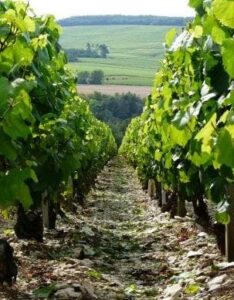
There are many things that go into making a great wine. Many oenophiles can argue well into the night about the relative merits of each, but it usually comes down to the same factors; the climate and conditions the year the grapes were harvested (otherwise known as the vintage); the type of grapes grown; the wine producer and their skill and techniques; and the elevation and soil type the grapes were grown in. It’s this last one that we’re interested in here – the soils and rock in the ground where the vines are planted, also known as terroir.
The main types of soil used for growing grapes are those containing limestone, clay, gravel, or sand. There are sub-categories to each of these (you may see loam, slate or schist, too). You might also come across the term ‘marl’ which denotes a mixture of clay and limestone. Pinot Noir in particular grows particularly well in marly soil.
As with all things in the world of wine, experimentation is the way to really learn, and there’s no substitute for trying wines from a variety of terroir to discover your favorites. The producers that Elden Selection work with make wines from a diverse range of soil types:
- Limestone is the common denominator in many of the best wines, not just from Burgundy, but from around the world. It helps drainage of the soil in cooler seasons, and retains moisture in the heat of the summer. Wines from limestone soil also show the good acidity found in some of the best vintages. The main type is Jurassic limestone, formed some 150 million years ago. The rock contains deposits of tiny, fossilized oyster shells which remind us that Burgundy once lay beneath a warm ocean. It is the same rock which the Channel Tunnel runs through, the same vein of rock which makes its way into south-east England. Chablis wines are known for growing in soils with shells and fossils in. Domaine Oudin’s 1er Cru Chablis showcases this stony minerality, and Jean Dauvissat ‘s 1er Cru ‘Vaillons’ combines it with vigour and fatness. In the Côte Chalonnaise, the villages of Givry, Mercurey and Montagny sit on layers of Jurassic limestone, with pebbly topsoils – look for the wines of Domaine Mouton, Domaine Jean Marechal, or Chateau Cary Potet for great expressions of this terroir.
- Clay is another type of soil which produces excellent wines – it stays cool and helps to retain water, especially when mixed with limestone to form marl. Such well-watered vines are able to produce muscular, strong wines which are round and generous in flavor – a particularly good example is Vosne-Romanée, which produces some of the finest Pinot Noir in the world from marl. Try the Domaine Jean Fery Vosne-Romanée ‘aux Reas’, the Capitain-Gagnerot ‘Aux Raviolles’ or the ‘Les Petits Monts’ from producer Marchand-Tawse.
- Sandy soils are perfect for wet climates as they encourage water drainage. They are also a natural and organic phylloxera protection, as the pests cannot survive on sand. Sand in Burgundy comes from granite, limestone and even quartz. Wines from sandy soil are often delicate, aromatic and paler than other wines. The wines of Savigny Les Beaune, hidden in a valley, come from sandy soils – look for reds by Jean-Jacques Girard or the white wine such as the Domaine Jean Fery Savigny les Beaune 1er Cru ‘Les Vergelesses’.
- Gravel offers other conditions for wine to grow in – it absorbs heat which reflects onto the grapes and can make wines have higher alcohol levels and sweetness. It’s especially useful in climates where the nights are cool, and the day’s heat is absorbed and then given out by the gravel. To the south of the Chassagne Montrachet, Pinot Noir flourishes in the higher concentration of red gravel and marl. Wines from the Côte de Nuits, especially from Chambolle-Musigny, benefit from gravel in the valley bottom, which ensures good drainage. Try the 1er Cru ‘Les Beaux Bruns’ from Thierry Mortet, or the the 1er Cru ‘Les Sentiers’ from Marchand-Freres. Some wines from Vougeot are also from gravelly soils, such as Domaine Jean Fery Vougeot 1er Cru ‘Les Cras’.
In Burgundy, more so than other regions, a significant amount of the nature and character (and price) of the wine is dictated by the terroir. No other French wine-growing region can be said to rely on geology as much for its reputation. Here, the soil in plots can vary from yard to yard, so that you may be walking on village-level vines with one footstep, and Premier Cru with the next.
The different types of soil impart subtle changes to a wine’s acidity, sweetness, minerality, body and a range of other factors. So next time you take a stroll in wine country, think about the earth you’re walking on – and let nature show you your favorite wines’ natural habitat, and why they flourish there.
